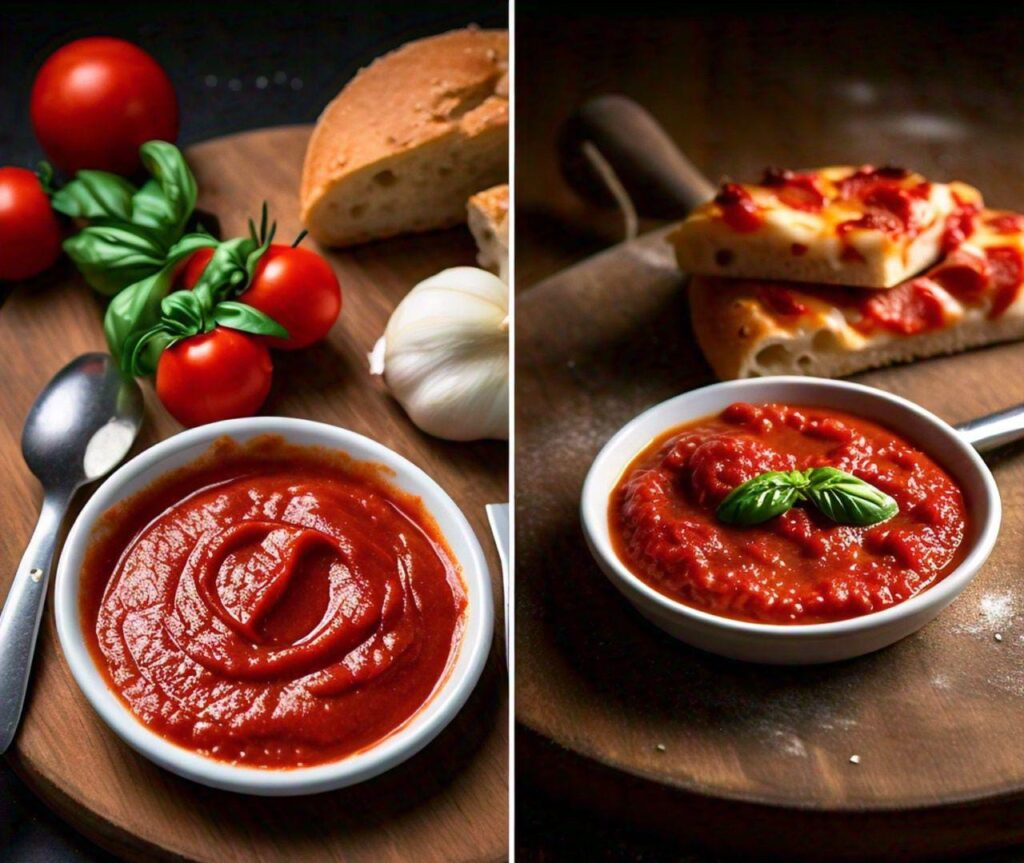Pizza sauce and marinara sauce – two staples in Italian cuisine that often get mixed up.Ever wondered what sets them apart? Understanding the differences can elevate your cooking game, whether you’re crafting a perfect pizza or whipping up a delightful pasta dish. Let’s dive into the world of these sauces and explore their unique characteristics.
What is Pizza Sauce?
Ingredients
Pizza sauce typically includes tomatoes, garlic, olive oil, and a variety of herbs like oregano and basil. Some recipes might call for a touch of sugar to balance the acidity of the tomatoes.
Preparation Method
Pizza sauce is usually made by blending tomatoes into a smooth consistency, then simmering the mixture with garlic, olive oil, and herbs. The goal is a thick, rich sauce that won’t make the pizza crust soggy.
Common Uses
As the name suggests, pizza sauce is primarily used as the base layer on pizza dough before adding cheese and other toppings. Its thick consistency ensures it stays in place during baking.

What is Marinara Sauce?
Ingredients
Marinara sauce is a simple, tomato-based sauce that includes tomatoes, garlic, onions, olive oil, and herbs like basil and oregano. Some variations might include a splash of red wine or a pinch of red pepper flakes for extra flavor.
Preparation Method
Unlike pizza sauce, marinara sauce often involves sautéing garlic and onions before adding tomatoes and herbs. The sauce is simmered to develop a deep, robust flavor and a slightly chunky texture.
Common Uses
Marinara sauce is incredibly versatile. It’s commonly used as a pasta sauce, a dip for breadsticks, a topping for meats, or a base for other dishes like lasagna.
Historical Background
- Origins of Pizza Sauce
Pizza sauce originates from Naples, Italy, the birthplace of pizza. The original Neapolitan pizza was made with simple, fresh ingredients, including a basic tomato sauce that has evolved into what we now know as pizza sauce.
- Origins of Marinara Sauce
Marinara sauce emerged in 16th-century Italy, following the introduction of tomatoes from the Americas. It was named “marinara” (meaning “mariner’s”) because it was a quick sauce prepared by sailors’ wives upon their return from sea.
Flavor Profiles
- Taste of Pizza Sauce
Pizza sauce has a concentrated tomato flavor, enhanced by garlic and herbs. It’s typically less acidic and slightly sweeter than marinara, designed to complement the other flavors on a pizza.
- Taste of Marinara Sauce
Marinara sauce boasts a bold, tangy flavor with a rich blend of tomatoes, garlic, and herbs. Its taste is often more complex due to the sautéing of garlic and onions, creating a robust, slightly chunky sauce.
- Texture and Consistency
Pizza Sauce Texture
Pizza sauce is smooth and thick, designed to create a stable base on the pizza crust without making it soggy. Its consistency ensures it adheres well to the dough.
Marinara Sauce Texture
Marinara sauce has a more rustic, chunky texture. The sautéed onions and garlic add bits of texture, and it’s usually thinner than pizza sauce, making it perfect for coating pasta or serving as a dip.
Nutritional Comparison
- Pizza Sauce Nutrition Facts
Pizza sauce is generally lower in calories, with a typical serving containing around 30-50 calories. It’s rich in vitamins A and C from the tomatoes, and also provides antioxidants like lycopene.
- Marinara Sauce Nutrition Facts
Marinara sauce is similarly low in calories, but might be slightly higher due to the inclusion of onions and olive oil. It also offers vitamins A and C, along with lycopene, making it a nutritious option for various dishes.
Culinary Uses
- Pizza Sauce in Dishes
While pizza is the primary use, pizza sauce can also be used in calzones, strombolis, and as a base for some casseroles. It’s perfect for any dish where a thick, stable tomato base is required.
- Marinara Sauce in Dishes
Marinara is extremely versatile. It’s perfect for pasta dishes, as a dip for mozzarella sticks, in meatball subs, or as a base for shakshuka.
Regional Variations
- Regional Pizza Sauce Variations
Different regions in Italy and around the world have their own takes on pizza sauce. Some might add anchovies, others might use different herbs. American-style pizza often uses a sweeter sauce compared to traditional Italian versions.
- Regional Marinara Sauce Variations
Marinara sauce also varies by region. Some versions might include olives, capers, or even seafood. The specific herbs used can also vary, reflecting local tastes and ingredient availability.
Pairing with Other Ingredients
- Pizza Toppings
Pizza sauce pairs well with a variety of toppings, from classic mozzarella and pepperoni to more gourmet options like prosciutto and arugula. The key is balancing the sauce’s sweetness and acidity with the toppings’ flavors.
- Marinara Accompaniments
Marinara is perfect with pasta, but also pairs beautifully with proteins like chicken or fish. It’s a fantastic dip for fried appetizers, and complements vegetables and grains in many dishes.
Making Homemade Pizza Sauce
Step-by-Step Recipe
- Ingredients.
- 2 cups crushed tomatoes2 cloves garlic, minced2 tbsp olive oil1 tsp dried oregano1 tsp dried basil
- Salt and pepper to taste
- Instructions.
- Heat olive oil in a pan over medium heat until shimmering.
- Add garlic to the heated olive oil and sauté until fragrant. Then, stir in crushed tomatoes, oregano, and basil.
- Simmer for 15-20 minutes until thickened. Season with salt and pepper
- Heat olive oil in a pan over medium heat until shimmering.
Tips and Tricks
Use high-quality tomatoes for the best flavor. To sweeten the sauce, simply add a pinch of sugar. For a smoother texture, blend the sauce after simmering.
Making Homemade Marinara Sauce
Step-by-Step Recipe
- Ingredients.
- 2 cups crushed tomatoes1 onion, finely chopped3 cloves garlic, minced2 tbsp olive oil1 tsp dried basil1 tsp dried oregano
- Salt, pepper, and red pepper flakes as your taste
- Instructions.
- Heat olive oil in a pan over medium heat.Add onion and sauté until translucent.Add garlic and cook until fragrant.Add crushed tomatoes, basil, oregano, and red pepper flakes.Simmer for 20-30 minutes.
- Season with salt and pepper.
Tips and Tricks
Simmer the sauce longer for deeper flavor. Add a splash of red wine for an extra layer of complexity. Use fresh herbs if available for a brighter taste.
Store-Bought vs Homemade
Pros and Cons of Store-Bought Pizza Sauce
Pros.
- Convenience
- Long shelf-life
Cons.
- May contain preservatives
- Often lacks the fresh taste of homemade
Pros and Cons of Store-Bought Marinara Sauce
Pros.
- Ready to use
- Wide variety of flavors
Cons.
- Can be high in sodium
- May not match the taste
In the battle of pizza sauce vs. marinara, both sauces have their unique charms and uses. Pizza sauce, with its thick, smooth texture and sweet, concentrated flavor, is perfect for creating the ideal pizza base. Marinara sauce, with its robust, tangy flavor and chunky texture, shines in a variety of dishes from pasta to dips. Whether you choose to make them at home or buy them from the store, knowing these details will certainly elevate your cooking game.
FAQs.
1. Can You Substitute One for the Other?
Yes, you can substitute pizza sauce for marinara and vice versa in many recipes. However, keep in mind that the texture and flavor might change slightly. Pizza sauce is thicker and smoother, while marinara is chunkier and has a more robust flavor.
2. How to Store Pizza and Marinara Sauce?
Both sauces can be stored in airtight containers in the refrigerator for up to a week. For longer storage, you can freeze them in freezer-safe containers or zip-lock bags for up to three months
3. What are Some Quick Ways to Enhance Store-Bought Sauces?
For pizza sauce, add a bit of fresh garlic, basil, or oregano. For marinara, sauté some onions and garlic and mix them into the sauce. Adding a splash of red wine or a pinch of red pepper flakes can further enhance the flavor.
4. Are Pizza Sauce and Marinara Sauce Healthy?
Both sauces can be healthy options, especially if made from scratch using fresh ingredients. They are low in calories and rich in vitamins A and C. However, be cautious with store-bought versions, which can be high in sodium and preservatives.




